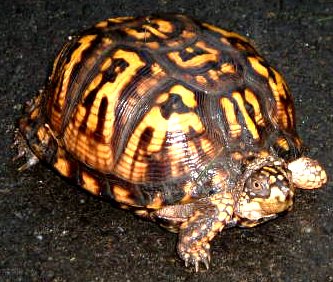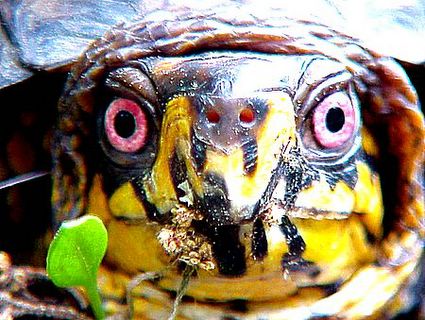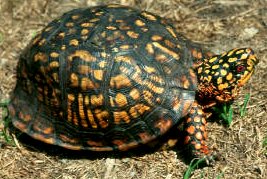Box Turtles
 My kids have been nagging me to get a pet, because they think it's too quiet back here in the bush and that I need something to talk to. I think (as I've said before) that having a pet might make me MORE nutty, and I do not want to talk to animals.
My kids have been nagging me to get a pet, because they think it's too quiet back here in the bush and that I need something to talk to. I think (as I've said before) that having a pet might make me MORE nutty, and I do not want to talk to animals.But I've considered a "herp." I don't think I'd be inclined to speak to a reptile.
If I had a totem, it would be the handsome box turtle. I enjoy turtle-rescuing season and will always screech to a halt at the sight of a turtle in the road. (If it's alive, that is.)
There are a lot of turtles around my place but we don't see them often. Once Zed saw one taking a huge bite out of a mushroom. Some box turtles are shy, some are valiant. Did you know the ones with red eyes and depressions in their lower shells (so they can get closer to their sweethearts) are male?
Below are extracts from a very old Durham Herald-Sun article by John H. Koontz.
Have you ever kept turtles successfully? Leave me some tips!
 ... "Box turtles make great pets," Jorgensen [a turtle maven] says. "They rarely bite, unless they're in great pain. They don't make noise. They don't do a whole lot of anything."
... "Box turtles make great pets," Jorgensen [a turtle maven] says. "They rarely bite, unless they're in great pain. They don't make noise. They don't do a whole lot of anything."Turtles in captivity need reptile food as a basic, along with supplements of phosphorus, calcium, and vitamins. Jorgensen gets these at pet stores.
 Her turtles also munch on fruit, vegetables, insects and worms. She says they'll follow you around the world for strawberries and watermelon. Remember to walk slowly. Turtles love meat, but it's unsafe to give them a steady diet of dog or cat food. Too much protein can be dangerous to turtles' kidneys.
Her turtles also munch on fruit, vegetables, insects and worms. She says they'll follow you around the world for strawberries and watermelon. Remember to walk slowly. Turtles love meat, but it's unsafe to give them a steady diet of dog or cat food. Too much protein can be dangerous to turtles' kidneys.Some flower gardeners love to have them around, since turtles love to eat slugs. Vegetable gardeners aren't as fond of them, because they're like humans with a Whitman's sampler - they take one bite from everything.
Having turtles has affected simple things in Jorgensen's life. She doesn't wear red socks, since turtles are attracted to the color red and she doesn't want to squash one of her pals.
 In her backyard, Jorgensen has made pens to keep her buddies. The walls of their enclosures are made from horizontal cross ties, topped with 3-foot wire fencing. Inside the pens are small houses, plants and swimming pools. During summer afternoons, the water turtles get to visit a larger pool where they can dive, cool out or play sunbathe-on-the-log.
In her backyard, Jorgensen has made pens to keep her buddies. The walls of their enclosures are made from horizontal cross ties, topped with 3-foot wire fencing. Inside the pens are small houses, plants and swimming pools. During summer afternoons, the water turtles get to visit a larger pool where they can dive, cool out or play sunbathe-on-the-log."I didn't know some female turtles can hold sperm inside themselves for up to five years," she says.
All winter Jorgensen looks forward to April, when her turtles come out of hibernation. "The males have one thing on their mind," she says, "making love."
The males spend most of early summer chasing females, who show little interest. Finally the males win out, and they do mate.
The females usually start laying eggs in June, and the eggs take 80 to 90 days to incubate, depending on the weather.
 After a 30-day gestation period, the females search out a place to lay eggs. They'll spend five hours or more to dig a hole four inches deep. They usually lay three to four eggs before covering them. Turtles often have two hatches a year.
After a 30-day gestation period, the females search out a place to lay eggs. They'll spend five hours or more to dig a hole four inches deep. They usually lay three to four eggs before covering them. Turtles often have two hatches a year.Sometimes Jorgensen ... scoops up the eggs using a plastic spoon. "Be gentle with the eggs." She's always careful to keep the same side of the eggs up, since letting them turn over can kill the embryo inside.
She puts the eggs into an aquarium containing moist sawdust and covers them with another two inches of sawdust. She has to monitor the moisture in the aquarium, since letting the environment get too dry can cause the babies to be born blind or deformed. Letting the sawdust stay too wet can also cause problems.
Jorgensen uses a thermometer to check the temperature. "If it stays near 70 degrees," she says, "most of the babies will be males. If it's nearer 80 degrees, most will be females."
 Doing things artificially speeds the process. The little ones come along in 65 to 75 days. Jorgensen says most turtle breeders uncover the eggs at day 65 to see how things are going. If the eggs are swollen and rounded, they're getting ready to hatch. ... she doesn't disturb the eggs any more.
Doing things artificially speeds the process. The little ones come along in 65 to 75 days. Jorgensen says most turtle breeders uncover the eggs at day 65 to see how things are going. If the eggs are swollen and rounded, they're getting ready to hatch. ... she doesn't disturb the eggs any more.Hatchlings have a slow climb to the top of the soil, taking as long as a month. If they're hatched late in the year, they'll go directly into hibernation and won't come out until spring. Hatchlings born in August and September are usually about the size of a dime.
When they're two weeks old, she begins feeding every other day. She says it's smart to use paper flooring ... peat moss can give them mites, and cedar chips have chemicals in them.
 Jorgensen warns that you shouldn't be surprised if baby turtles die. A mortality of 10 to 50 percent is normal.
Jorgensen warns that you shouldn't be surprised if baby turtles die. A mortality of 10 to 50 percent is normal.If you have the flu, you shouldn't handle turtles, because they're prone to respiratory disease. Keeping them in a warm room helps when they are sick.
Since turtles' ears can't drain, they're prone to ear infections. Treatment involves having the abscess lanced.
 "The best way to separate two turtles that are biting each other is to drop them into water. Sooner or later, they'll let go or drown."
"The best way to separate two turtles that are biting each other is to drop them into water. Sooner or later, they'll let go or drown."- The North Carolina Herpetology Society
- Box Turtle Care
- General Care of American Box Turtles
- Box Turtle Care and Conservation
- You can join the yahoo Box turtle list
In the course of writing this entry I've decided I won't be giving this a try, primarily because of what I read at the excellent Pioneering Box Turtle Conservation Strategies. This site says box turtles reproduce very slowly over the more than 120 years they can live in the wild, and that due to predators and disease a female may bring perhaps only 3 offspring to adulthood over that time.
We who ignorantly (if innocently) collected box turtles for "pets" were oblivious to the impact of our action: After we took our few pets, we could look around and see "LOTS" of adults still left in the woods the rest of our lives ... but since adults live so long, the population we saw was an increasingly "geriatric" one with too few young to sustain it in the distant future. This impact mushroomed by 1990 as escalating pet collecting removed tens of thousands each year for the international pet trade alone!On the other hand, Michael J. Connor's website gives more optimistic information.
A released turtle has a homing instinct that causes it to search for its home; a box turtle moved much more than a quarter mile is not likely to find its way back home ... its subsequent fruitless searching (which can last for years)
The magnitude of the displaced turtle problem can be mitigated if people learn to stop moving box turtles from native homes. When found crossing a road, they should be helped to the side toward which they are headed (and hope that they spend most of their time in the adjacent woods, away from that highway, thereafter).
McKeever's first hatchlings came in 1996 from a nest that was protected by screen installed by volunteer Clarion U. student, Ann Davis, following her late night vigil to guard any nesting females. All hatchlings were eaten by raccoons the following year; the predators breached the fenced enclosure designed to protect young during their first 6-7 years in the McKeever habitat. The hatchling enclosure now receives additional protection from an electrified perimeter. Click here to see the hatchlings.
I maintain an adult pair that I have had for over 6 years in a 10 feet by 12 feet pen. They spend much of their time buried in the mounds of compost provided for them with only their heads showing, ever alert for any food item that may go by. While having the typical preference for live food (snails and worms) and fruit, they seem to eat more green vegetables than my other box turtles. I supplement this diet with Purina trout chow, which they eat with gusto. I have observed mating only in the spring. The female is prolific, laying multiple clutches of 4-5 eggs, and always late at night. I usually harvest the eggs and incubate them indoors, but for the last 3 years hatchlings have appeared in the enclosure from undetected nests. Finding these hatchlings can be a real chore. They tend to remain hidden under the compost. I rear the hatchlings indoors on a moist potting soil substrate that is deep enough for them to bury themselves in. The hatchlings will learn to eat trout chow, and I have raised them to adulthood almost entirely on trout chow and small amounts of seasonal fruits.
Technorati Tags: Turtles, Pets



 A few of my daughter
Melina's great posts:
A few of my daughter
Melina's great posts:








14 Comments:
Thank you for the interesting article on Box Turtles. I will return to study this later and see what I am doing right and wrong. My daughter left me with 2 of them when she took off for college- she will be a jr this year. I will be stopping by occasionally to see what you are posting- it is interesting. Blogging- what a great way to meet people. Kinda like driving by and peeping in through open curtains at night only with permission.
I never knew I had the slightest interest in the Box Turtle... but this was really an interesting bit (bits) of info... I honestly just never considered keeping them, or dealing with hatchlings. And isn't that little guy with the quarter cute! Did he get it for losing his shell tooth? (tutles DO have a shell tooth, yes?)
tortuga?
TORTUGA?!
ese es mi espiritu!
tal vez la vida que viene despues de esta nos vera a los dos igual...
one can only hope!
thanks!
This is Tangled Bank material.
how would I spot the box turtle hatchlings in the wild in order to take pictures? I'v looked for hatchlings in the wild for more than ten years to no avail. I'm located in Virginia. Where should I look? How would I spot nests and hatchlings?
I just saw a turtle digging a hole last night about 6 yards from my front door. I have seen sea turtles lay eggs before and that is what it reminded me of. I am in Northeast Florida and it is June 6. It was nice reading your article as I was interested in how long it takes for the eggs to hatch, how many baby turtles there might be and how big they would be. I am thinking of putting some kind of screen around the nest to protect it from racoons. I hope we catch sight of the babies as the emerge. I have a 9 year old son and a 6 year old daughter and I know they would enjoy it too!
Oh and as far as what it looks like, you would be hardpressed to find one in the woods. She covered the hole up and there is no mound. It looks like just a few inches of scratched dirt.
i have 2 box turtles and i feed them fruit and vegies and dip them in room tepature water
I have two box turtles. One male and one female. How do you know when they are about to lay eggs? I know they have mated many times and I read on your site that they can hold sperm for up to five years. But is there any sign to let you know if babies are in your near future?
I have 4 box turtles, one that I have had for 25 years, one that I have had for 24 years, one that I have for 22 years, and one that I have had for 21 years. 2 are female are 2 are male. I have a large indoor pen and a large outdoor pen. The indoor has plexiglass dividing it into 3 sections: males at each end and females in the middle. I tried setting up the outdoor one similar fashion, but no avail. The males kept getting through. During the summer months, all females stay outside and each male gets rotated outdoors on a weekly basis. Only recently did life present the opportunity to own a home and have females in an outdoor pen. They've laid eggs constantly, but since there's nowhere to bury them, they usually wind up getting eaten by the other turtles. At the end of April, I observed Maude digging about a 4-inch deep hole, laying eggs, and burying them. I chose not to disturb the nest, but I am planning on somehow partitioning that section off since I fear the adults will attempt to eat the young. It's now June and I sleep with my fingers crossed!
I have been trying to see if my female turtle is laying a normal amount of eggs. I only have one male and one female. I noticed she laid eggs one night last summer so I dug them up. I found 3 eggs. When those eggs started to hatch I was so excited! but only two did hatch. Still I was thrilled to have two babies. Then began the finding of more babies in the outdoor habitat. Every day I went out to the pen I found another baby. I found two dead from lack of water I think. I was up to 8 babies. I thought, "wow she must have laid 10 eggs." Little did I know that there were still even more babies to find. After a winter with 14 degrees at night this spring another baby appeared. Wow he survived outside all winter! The next day another baby was found. Then another then another. I found one sick one morning and tried to make it better but it did not survive. Then my neighbor told me a dead turtle was in her yard. Probably her cat got it. After counting the ones I have alive and the ones that died I have realized that my female laid 18 eggs. I'm pretty sure some of those eggs overwintered and didn't hatch until our first rains this spring. WOW! Super mamma!She picked great spots for eggs to be laid. But I've heard that box turtles lay 3-4 eggs in several clutches. That still would be 8 to 12 eggs. I'm thinking my girl is up for mamma of the year. LOL. Since the last baby I found was just two days ago I'm still looking out there to see if anymore show up. Crazy huh?
Me and my buddy just came upon a box turtle laying eggs in the wild. We timed it just perfect as she was dropping egg number one within five minutes of finding her. We too wondered what the time period would be for the young to hatch. Pretty exciting stuff. We too had seen shows on sea turtles but everyone agreed that they'd never thought much about box turtles mating and hatchlings. Looking forward to checking up on the eggs in two and a half months! Keep up the good work.
hey, I have 7 box turtles but i never have more than 3 in an enclosure at once. Usualy i only have 4 of them in captivity at once, and generaly, i find injured turtles and nurse them back to health. The very 1st box turtle i found and nursed was a male, and he was much esier than most of the females iv had. He was not shy at all. therefor he was easy to feed and care for. he always runs away at the beginning of mating season, and returns to the two females he left behind about half way through the mating season. hes so funny. I have found tha one way or another, turtles are always ending up on my doorstep, injured or in need of food or care. I believe God is using me to care for this species of his creation in my area.
We've had a male for 3 years and a female for 2 years and have never seen the nest of eggs...we only see the eggs that have a compression dent or open with dark mud-like stuff inside...AND no evidence of a young turtle...We have recently found a different type of land turtle that we believe is a female...she has some red under her eyes and chin area...They all live in an enclosed area in our backyard in New Mexico
Thank you for the very interesting article. I had started looking up some info because a turtle was in my back yard digging three holes and I had no idea why. Guess it was to lay some eggs. Wonder if I should put some chicken wire around and over the covered holes since I have cats and there are cats that come for a visit. Also opossums and raccons. What would you suggest? Thank you
Post a Comment
<< Home